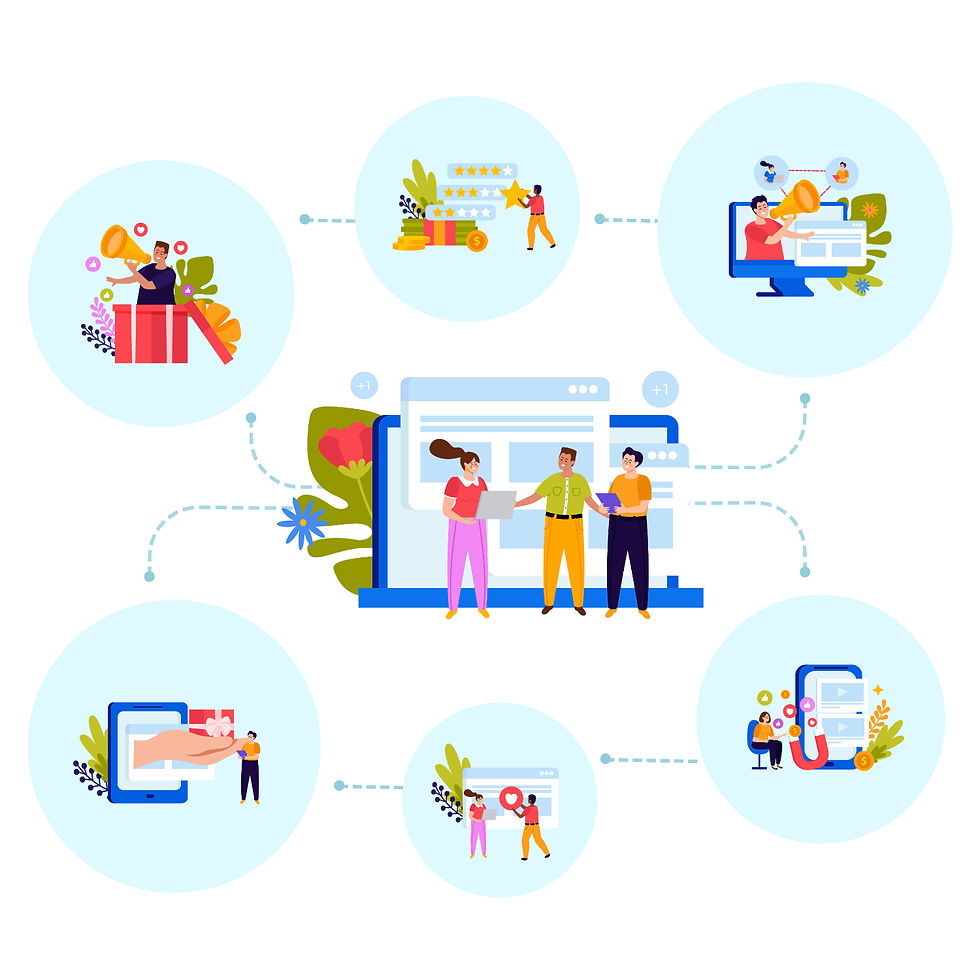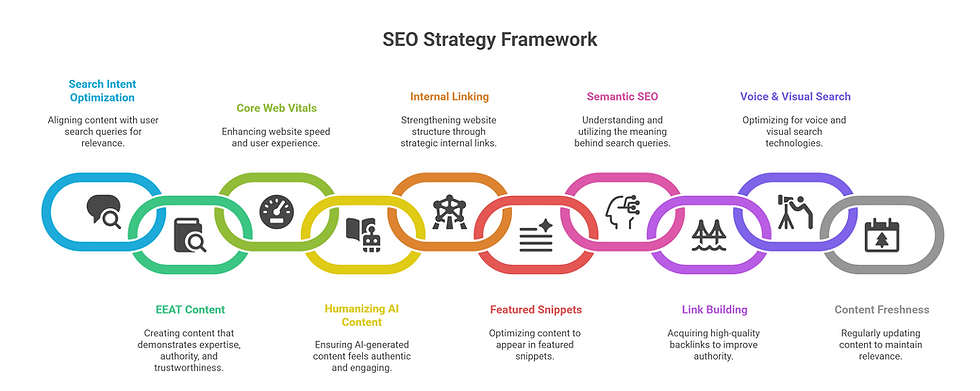Top Digital Marketing Trends in India for 2025
- jjanawork
- Jul 26, 2025
- 6 min read
Updated: Jul 27, 2025

The digital world in India is experiencing a rapid change. As the country is expected to have more than 1 billion internet users by 2025, digital marketing is not an option anymore; it is the foundation of business development. In the case of digital agencies, SaaS platforms, e-commerce startups, business coaches, and consultants, it is essential to keep up with the changing trends to scale and differentiate.
1. AI-Powered Personalization & GenAI Content

Artificial Intelligence (AI) is transforming digital marketing by enabling the creation and delivery of hyper-personalized content at scale. It enables companies to know, anticipate, and react to customer actions in real time.
Why it's important:
Marketers can use AI tools such as Jasper, ChatGPT, and Gemini to customize Google to write blogs, emails, ad copy and social posts within minutes.
Predictive customer insights and automation based on behavior are possible with AI integrations in tools such as HubSpot, Salesforce, and Zoho.
How It helps your Brand
Personalized Campaigns: AI can segment users by behavior, demographics, or lifecycle stage, allowing personalized communication.
Time Efficiency: Content ideation, A/B testing, and optimization are quickened.
Better Conversions: AI makes messaging to the correct audience at the correct time.
Example: A SaaS company employs AI to track user activity on its product dashboard. When a user spends a lot of time in a particular feature, the AI engine will send a sequence of personalized emails on how to become a pro in that feature, and the product will be adopted better.
Key Takeaway: Use AI not only to automate but also to personalize. It is the most intelligent method of scaling relationships in a digital world.
2. Voice Search and Multilingual SEO

India is the only country with more than 22 official languages and a high usage of voice assistants, making it a perfect place for a voice and vernacular search revolution.
Why this trend matters:
Voice search is used by more than 65 percent of internet users in India.
Tier 2 and Tier 3 cities like to consume local language content.
How to optimize for this:
Conversational Keywords: Consider the way people talk, not write. E.g., the best dosa place near me rather than the top South Indian restaurant.
Local Language Content: Translate or produce original content in Hindi, Bengali, Tamil, Marathi, etc.
Schema Markup: Assists Google in comprehending content and enhancing featured snippets, particularly voice search.
Example: A government exam coaching center in Pune posts blogs and videos in Marathi, featuring questions such as "MPSC la kasa tayar rahaycha?" that have a more local reach and traffic.
Key Takeaway: The brands that will gain trust and traffic in 2025 are those that will accept the linguistic diversity of India.
3. Short-Form Video & Snackable Content

The focus is getting shorter, and people want to read something fast and interesting that they can read on the move.
Why it’s trending:
Instagram Reels, YouTube Shorts, Moj, and Josh are on a roll in India.
Algorithms favor short-form videos as opposed to static posts and carousels.
Tips for winning with short-form video:
Stick to educational, motivational, or relevant content.
Use subtitles, hooky headlines, and vertical format.
Video scripts can be repurposed into blogs or FAQs.
Example: A digital marketing consultant shares a 30-second reel titled, 3 cost-effective methods to increase SEO. It goes viral, getting leads from freelancers and startups.
Key Takeaway: Short-form video is not an option anymore. If your brand is not appearing in reels or shorts, you are missing reach.
4. Micro-Influencer and Regional Creator Partnerships

Micro-influencers and local content creators are now more cost-effective than national celebrities.
Why Brands Prefer Them:
Micro-influencers are trusted by 82 percent of consumers.
They have real, loyal followers in particular niches.
How to build regional influencer campaigns:
Find influencers via Winkl or Plixxo, or do it manually via Instagram/TikTok search.
Monitor the engagement rate and demographics of the audience, not only followers.
Testimonials, product demonstrations, or storytelling in local dialects should be done in collaboration.
Example: A D2C health drink brand partners with 4 Gujarati-speaking fitness influencers for Navratri content. The campaign leads to a 40 percent increase in direct sales in Gujarat.
Key Takeaway: Regional influencers are in the language of the customer, literally and culturally. Partner smartly.
5. Non-Linear Omnichannel Marketing

By 2025, the purchase path is zigzagging across the various channels. Customers find you on social media, read about you on Google, read reviews on YouTube, and purchase through WhatsApp.
Why Omnichannel Matters:
It creates familiarity and trust.
It provides the user with several points of entry to engage and convert.
How to create an omnichannel strategy:
Make sure that the brand is consistent in the message, visuals, and tone on all platforms.
Monitor interactions with the help of CRM tools such as Zoho, HubSpot, or Mailchimp.
Message tailoring by intent and stage (awareness vs. purchase).
Example: A fintech brand applies Instagram to post customer testimonials, Google Ads on particular services, Thought leadership on LinkedIn, WhatsApp Business API to exchange documents and set demos
Key Takeaway: You do not need to be everywhere, but be where it matters and make it consistent.
6. Privacy-First Marketing & Ethical Data Collection

As more and more regulations are put in place, such as the Digital Personal Data Protection (DPDP) Act, ethical marketing is not a fad; it is a requirement.
What this means:
There is an increase in cookieless advertising.
Customers want to have control over their data.
Steps to stay ahead:
Leverage first-party data tactics: newsletter signups, gated content, and surveys.
Display clear privacy notices and opt-in.
Implement Google Analytics 4 (GA4) and tools that are in line with international data regulations.
Example: A legal consultancy develops an eBook that can be downloaded on new property laws. It has to be opted in by users. This assists in creating a clean email list of high-intent leads.
Key Takeaway: Ethical marketing creates long-term trust. Make it part of your brand DNA.
7. Social Commerce & In-App Shopping

Social networks are becoming complete shopping places.
What’s hot:
WhatsApp product catalogs, Instagram Shop, and shoppable YouTube videos.
Live shopping or reels.
How to integrate:
Create your Instagram/Facebook shop with the right product tags.
Produce educational content that sells (e.g., styling tips, tutorials).
Collaborate with designers to feature products on the fly.
Example: A sustainable fashion brand organizes an Instagram Live once a week to show new collections. The shop tab allows viewers to buy immediately.
Key Takeaway: Decrease the number of steps between discovery and purchase. Take your shop to the scroll.
8. Immersive AR/VR Experiences

Engaging content helps make better decisions and increases confidence to buy.
Industries benefiting:
E-commerce: Virtual tries
EdTech: Mock learning conditions
Real Estate: Virtual tours of property
How to begin:
Take advantage of such tools as Spark AR, Adobe Aero, or WebAR.
Include AR demos on landing pages or galleries.
Example: A skincare brand develops an AR filter that allows people to see how various lipstick colors look in Instagram Stories. It experiences a 3-fold increase in add-to-cart.
Key Takeaway: Immersive tech closes the gap of imagination, turning curiosity into conversions.
9. Upskilling & Strategic Thinking
Clients are demanding more than execution; they are demanding thought leadership and business alignment.
Skills in demand:
Marketing automation (e.g., Klaviyo, ActiveCampaign)
Funnel optimization
Storytelling and analytics
Conversion Copywriting
How to position yourself:
Provide workshops, webinars, or lead magnets to demonstrate knowledge.
Post process breakdowns and real case studies on LinkedIn.
Advise clients on more than content scale, audience fit, and retention.
Example: A marketing consultant does not only create blogs about a SaaS tool but also develops a 3-month email automation sequence. Consequently, the brand experiences user retention growth by 35 percent.
Key Takeaway: Strategic thinkers charge higher fees and client relationships. Not only hands, but also brain.
Final Thoughts: Be the Brand That Leads
The digital world of India by 2025 is dynamic, rapid, and opportunity-rich. No matter whether you operate a B2B SaaS product, a personal coaching brand, or a digital agency, these trends will be the key to better visibility, higher engagement, and smarter conversions. Whether you need high-performing content, voice search search engine optimization, or a data-driven growth strategy that targets Indian markets—say, talk. We assist B2B brands, agencies, and experts in growing with smart content, imaginative campaigns, and digital infrastructure.
Stay informed. Stay relevant. Let us develop in 2025—together.

Comments